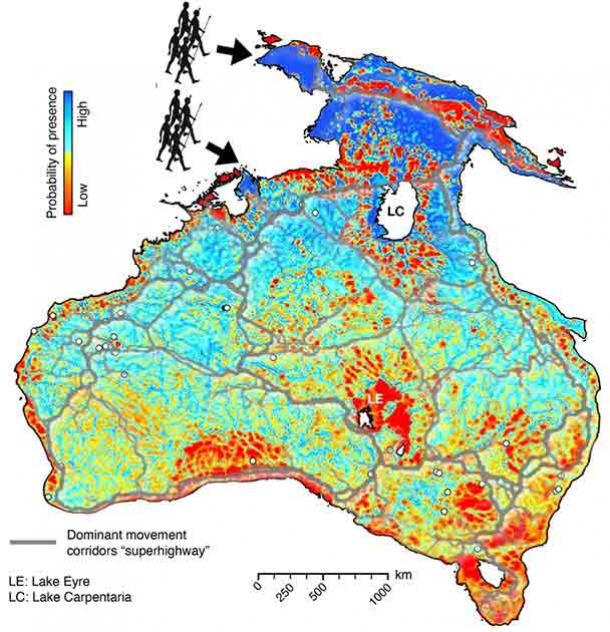How Evolving Landscapes Impacted First Peoples' Migration to Australia
For the first time, dynamic modelling of terrain has helped us better understand how humans first travelled across the continent of Sahul between 35,000 and 70,000 years ago.
New research led by the University of Sydney offers fresh understanding of the migration patterns of Australia and New Guinea’s First Peoples, and where they lived in the 40,000 years following humanity’s arrival on the then combined continent.
Using a dynamic model charting the changing landscape, researchers have provided a more realistic description of the of the areas inhabited by the first humans to traverse Sahul: the landmass combining what is now Australia, Tasmania and New Guinea.
A new Approach to the Question of Sahul Migration
Led by Associate Professor Tristan Salles from the School of Geosciences at the University of Sydney, the research model factors-in evolution of the landscape, driven by climate, during the time of human dispersal. This is a novel approach; previous studies of migration patterns have relied heavily on archaeological findings.
“One aspect overlooked when evaluating how people spread across the continent is the evolution of the Earth’s surface which took place as people migrated,” Associate Professor Salles said.
“Yet landscapes and landform are deeply engraved in Aboriginal culture.”
- Virtual Reality Tracks 75,000-Year-Old Footsteps of Sahul Explorers
- Ancient Ancestors Made A Large and Deliberate Migration to Australia

Associate Professor Tristan Salles. (University of Sydney)
Humans first set foot on Sahul around 75,000 years ago. The research team used an established landscape evolution model detailing climatic evolution from 75,000 to 35,000 years ago. The model offers a fresh perspective on terrains and environments inhabited by the first hunter-gatherer communities as they traversed Sahul.
Researchers ran thousands of simulations to describe possible migration routes originating from two entry points into Sahul: a northern route through Western Papua and a southern route from the Timor Sea shelf.
Their results were consistent with previous findings, predicting a high likelihood of human occupation at already iconic archaeological sites such as: Ngarrabullgan Cave (in North Queensland), the Puritjarra rock shelter (Central Australia), and the Riwi Cave and Carpenter’s Gap 1 rock shelter in the Kimberley (Western Australia).
- Pemulwuy: Prominent Aboriginal Rebel Leader Murdered in 1802 AD
- Following the Footsteps of the Ancestors: The Walkabout Coming of Age Ceremony

Predicted human presence across Sahul 35,000 years ago. (University of Sydney)
A Gradual Spread Through the Region
Results indicated migration speeds of between 360 meters and 1.15 kilometers a year, depending on entry points and arrival times. They also show that human settlers would have dispersed across the continental interior along river corridors on both sides of Lake Carpenteria.
“Our palaeoecological reconstructions show evidence of diverse interior habitats varying from high altitude tropical forest, subtropical savannah to semiarid woodland and grassland,” Associate Professor Salles said.
Instead of finding well-defined migration routes (indicated by the grey lines on the below map), the research suggests a radiating wave of migration following rivers and coastlines. This correlates with known migration corridors: east of Lake Carpentaria following the Great Dividing Range; southern corridors connecting Lake Eyre to the eastern corridors; and the central super-highways transecting Australia’s arid interior.
Used in conjunction with mechanistic simulations, the findings could help evaluate how often a specific location is likely to have been visited.
“This could help identify new areas of archaeological interest as a precursor to more costly and time-consuming archaeological surveys,” Associate Professor Salles said.
Top image: Globe map image of the region of Australia, Tasmania and New Guinea and now submerged land which once made up the Sahul landmass. Source: ink drop/Adobe Stock
The article, ‘How Evolving Landscapes Impacted First Peoples' Migration to Australia’ was first published by University of Sydney, and provided by Science Daily.
Source: University of Sydney. "How evolving landscapes impacted First Peoples' early migration patterns into Australia." ScienceDaily. ScienceDaily, 30 April 2024. www.sciencedaily.com/releases/2024/04/240430105606.htm
References
Tristan Salles, Renaud Joannes-Boyau, Ian Moffat, Laurent Husson, Manon Lorcery. Physiography, foraging mobility, and the first peopling of Sahul. Nature Communications, 2024; 15 (1) DOI: 10.1038/s41467-024-47662-1















